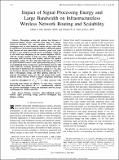| dc.contributor.author | Dai, Lillian L. | |
| dc.contributor.author | Chan, Vincent W. S. | |
| dc.date.accessioned | 2010-03-10T21:04:55Z | |
| dc.date.available | 2010-03-10T21:04:55Z | |
| dc.date.issued | 2009-03 | |
| dc.date.submitted | 2008-12 | |
| dc.identifier.issn | 1536-1276 | |
| dc.identifier.uri | http://hdl.handle.net/1721.1/52490 | |
| dc.description.abstract | Throughput scaling and optimal hop distance of interference-limited wireless networks have been well characterized in literature. For some emerging wireless networks, throughput may be more limited by battery energy rather than by interference. In characterizing throughput scaling and optimal hop distance of such power-limited networks, prior work have invoked a zero signal processing energy assumption, which led to the belief that whispering to the nearest neighbor (WtNN, with the average number of hops per source destination pair increasing with increasing node density) achieves the optimal throughput scaling. We show that this belief must be modified for power-limited networks when signal processing energy is not an insignificant factor. In fact, for a power-limited network with nodes uniformly randomly distributed in a bounded region and in the limit of interference-free operation, taking Theta(1) (i.e. does not increase or decrease with increasing node density) number of hops is throughput, energy, and delay optimal, achieving Theta(1) pairwise throughput, energy per bit, and packet delay under uniform traffic, whereas WtNN is strictly suboptimal, achieving a pairwise throughput of O(logradic( n/ n)), which decreases with increasing node density. In addition, we show that a constant characteristic hop distance of d[subscript char] simultaneously achieves the pairwise throughput scaling and minimum network energy consumption for random networks. | en |
| dc.description.sponsorship | National Science Foundation (grant ANI-0335256) | en |
| dc.language.iso | en_US | |
| dc.publisher | Institute of Electrical and Electronics Engineers | en |
| dc.relation.isversionof | http://dx.doi.org/10.1109/twc.2009.080762 | en |
| dc.rights | Article is made available in accordance with the publisher's policy and may be subject to US copyright law. Please refer to the publisher's site for terms of use. | en |
| dc.source | IEEE | en |
| dc.title | Impact of signal processing energy and large bandwidth on infrastructureless wireless network routing and scalability | en |
| dc.type | Article | en |
| dc.identifier.citation | Dai, L., and V. Chan. “Impact of signal processing energy and large bandwidth on infrastructureless wireless network routing and scalability.” Wireless Communications, IEEE Transactions on 8.6 (2009): 3112-3121. © 2009 IEEE | en |
| dc.contributor.department | Massachusetts Institute of Technology. Department of Electrical Engineering and Computer Science | en_US |
| dc.contributor.approver | Chan, Vincent W. S. | |
| dc.contributor.mitauthor | Dai, Lillian L. | |
| dc.contributor.mitauthor | Chan, Vincent W. S. | |
| dc.relation.journal | IEEE Transactions on Wireless Communications | en |
| dc.eprint.version | Final published version | en |
| dc.type.uri | http://purl.org/eprint/type/JournalArticle | en |
| eprint.status | http://purl.org/eprint/status/PeerReviewed | en |
| dspace.orderedauthors | Dai, L.; Chan, V. | en |
| dc.identifier.orcid | https://orcid.org/0000-0002-8274-6636 | |
| mit.license | PUBLISHER_POLICY | en |
| mit.metadata.status | Complete | |
